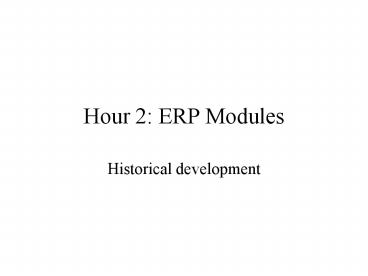Hour 2: ERP Modules PowerPoint PPT Presentation
1 / 33
Title: Hour 2: ERP Modules
1
Hour 2 ERP Modules
- Historical development
2
Historical
- Initial Computer support to business
- Easiest to automate payroll accounting
- Precise rules for every case
- Early 1970s
- centralized mainframe computer systems
- MIS systematic reports of financial performance
- Variance analysis between budget and actual
3
MRP
- Material requirements planning
- Inventory reordering tool
- Evolved to support planning
- MRPII extended to shop floor control
4
SAP Modules
5
Comparative Modules
6
Industry-Specific Focus
- Each vendor has turned to customized ERP products
to serve industry-specific needs - Examples given from BAAN, PeopleSoft
- Microsoft also has entered the fray
7
BAAN Industry-Specific Variants
8
PeopleSoft Industry Solutions
9
Microsoft Great Plains Business Solutions
10
Relative ERP Module Use(Mabert et al. 2000
Olhager Selldin, 2003)
11
Relative Module Use
- Mabert et al. (2000) surveyed Midwestern US
manufacturers - Some modules had low reported use (below 50 in
red) - Financial Accounting most popular
- Universal need
- Most structured, thus easiest to implement
- Sales Marketing more problematic
12
Why Module Use?
- Cost
- Cheaper to implement part of system
- Conflicts with concept of integration
- Best-of-Breed concept
- Mabert et al. found only 40 installed system as
vendor designed - 50 used single ERP package 4 used
best-of-breed - Different vendors do some things better
- Conflicts with concept of integration
13
Middleware
- Third-party software
- Integrate software applications from several
vendors - Could be used for best-of-breed
- Usually used to implement add-ons (specialty
software such as customer relationship
management, supply chain integration, etc.)
14
Customization
- Davenport (2000) choices
- Rewrite code internally
- Use existing system with interfaces
- Both add time cost to implementation
- The more customization, the less ability to
seamlessly communication across systems
15
Federalization
- Davenport (2000)
- Roll out different ERP versions by region
- Each tailored to local needs
- Core modules shared
- some specialty modules unique
- Used by
- Hewlett-Packard
- Monsanto
- Nestle
16
EXAMPLES
- Dell Computers
- Chose to not adopt
- Siemens Power Corporation
- Implementation of selected modules
17
Dell Computers
- Evaluation of SAP R/3
18
Need to continue project evaluation
- Initial project adoption
- 1994 Dell began implementation of SAP R/3
enterprise software suite - Spent over 1 year selecting from 3,000
configuration tables - After 2 year effort (200 million), revised plan
- Dell business model shifted from global focus to
segmented, regional focus
19
Rethinking
- In 1996 revised plan
- Found SAP R/3 too inflexible for Dells new
make-to-order operation - Dell chose to develop a more flexible system
rather than rely on one integrated, centralized
system
20
Best-of-Breed
- I2 Technologies software
- Manage raw materials flow
- Oracle software
- Order management
- Glovia software
- Manufacturing control
- Inventory control
- Warehouse management
- Materials management
- SAP module
- Human resources
21
Core Competencies
- Glovia system interfaced with
- Dells own shop floor system
- I2 supply chain planning software
- This retained a Dell core competency
- Would have lost if adopted publicly available
system
22
Points
- Demonstrates the need for speed
- Prolonged installation projects become outdated
- Need to continue to evaluate project need after
adoption - Tendency to stick with old decision
- But sunk cost view needed
- Demonstrates need to maintain core competitive
advantage - Adopting vendor ERP doesnt
23
Siemens ERP ImplementationHirt Swanson (2001)
- Nuclear fuel assembly manufacturer
- Engineering-oriented
24
Siemens Power Corporation
- 1994 Began major reengineering effort
- Reduced employees by 30
- 1996 Adopted SAP R/3 system
- Replacement of IS budgeted at 4 million
- Some legacy systems retained
25
Siemens Modules
- FI Finance
- CO Controlling
- AR Accounts receivable
- AP Accounts payable
- MM Materials management
- PP Production planning
- QC Quality control
26
Implementation
- To be led by users
- Project manager from User community
- Consultant hired for IT support
- IS group only marginally involved
27
Project Progress
- Oct 1996 Installed FI module
- Sep 1997 Installed other modules
- On time, within budget
28
Permanent Team
- Made project team a permanent group
- Project manager had been replaced
- 2nd PM retained
- SAP steering committee
- SAP project team formed
29
SAP steering committee
- 7 major user stakeholders
- Guided operating policy
- major expenditures
- major design changes
30
SAP project team formed
- 15 members from key user groups
- part-time
- Trainer
- User help
- Advisors to middle management
31
Training
- End users became more proficient with time
- Average of 3 months to learn what needed
- Management training took longer
- Management didnt understand system well
- Often made unrealistic requests
32
Operations
- During first year
- Major errors in ERP configuration
- Evident that users needed additional training
- New opportunities to change system scope
suggested - Two years after installation
- R/3 system upgrade
33
Summary
- Core idea of ERP complete integration
- In practice, modules used
- More flexible, less risk
- Can apply best-of-breed concept
- Ideal, but costly
- Related concepts
- Middleware integrate external software
- Customization tailor ERP to organization
- Federalization different versions of ERP in
different organizational subelements

